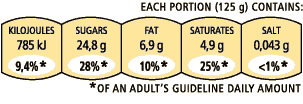SPAR has taken steps to ensure that it stays in line with global trends by incorporating these helpful 'Guidelines on Daily Amounts' (GDA) icons on food packaging. Today's health conscious consumer has a right to make an informed decision on the foods they purchase and these icons will provide that information in an instant. The percentage value in each block is based on the recommendations for an average adult of healthy weight and average activity level.

Kilojoules
The amount of energy that a food provides (through its combined nutrients) is quantified as kilojoules. We need energy to survive but it is important to remember:
- If you consume more kilojoules than you burn in a day you may gain weight
- If you burn more kilojoules than you consume in a day you may lose weight
The GDA for kilojoules is 8368 kJ.
Sugar
Sugar is a great source of energy and it adds sweetness to food. It is important not to consume too much sugar as it can cause diabetes, weight gain and dental decay. The average person should not consumer more than 90 g of sugar per day.
The GDA for sugar is 90 g.
Fat
Fat is an essential component of a healthy diet, but it is very high in kilojoules and can therefore lead to weight gain if consumed in excess.
The GDA for fat is 70 g.
Saturates
We should all be aware of the amount of saturated fats or animal fats we consume. When eaten in excess they are responsible for elevated cholesterol levels which may in turn lead to heart disease.
The GDA for saturates is 20 g.
Salt
Although salt is essential to optimal body functioning it is also high in sodium. Sodium is the part of salt which is linked to raised blood pressure and heart disease.
The GDA for Salt is 6 g.